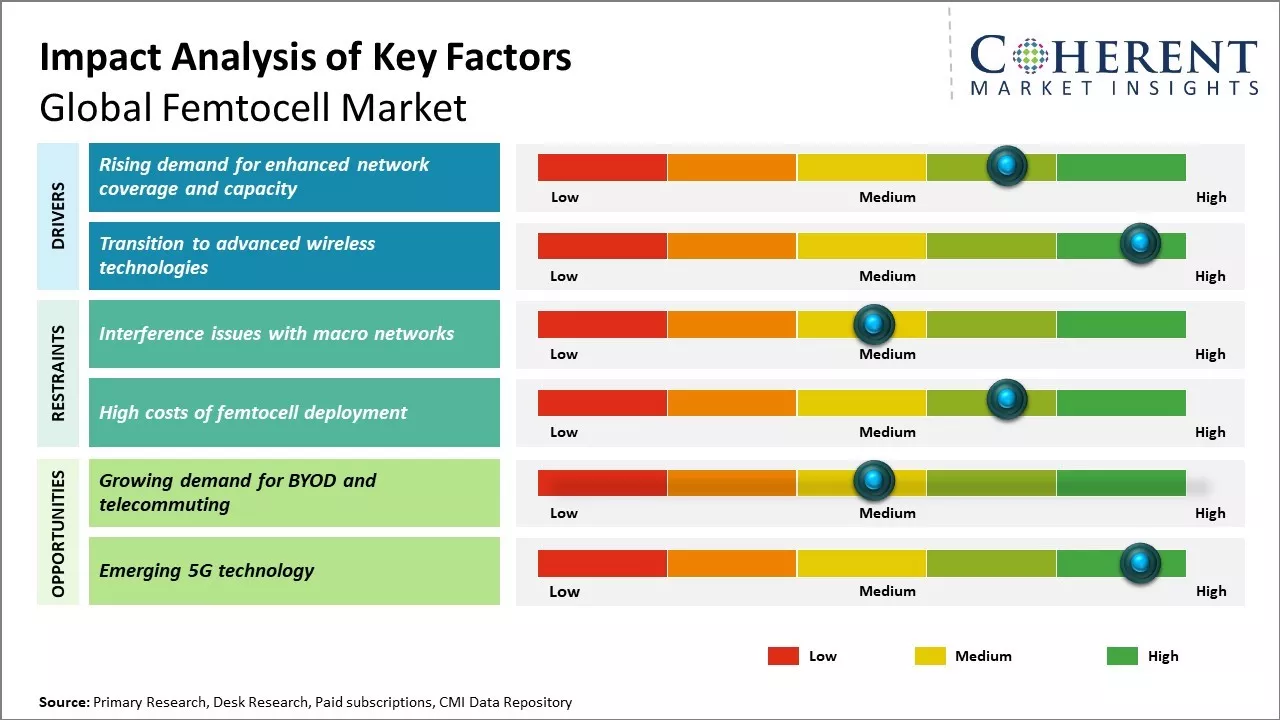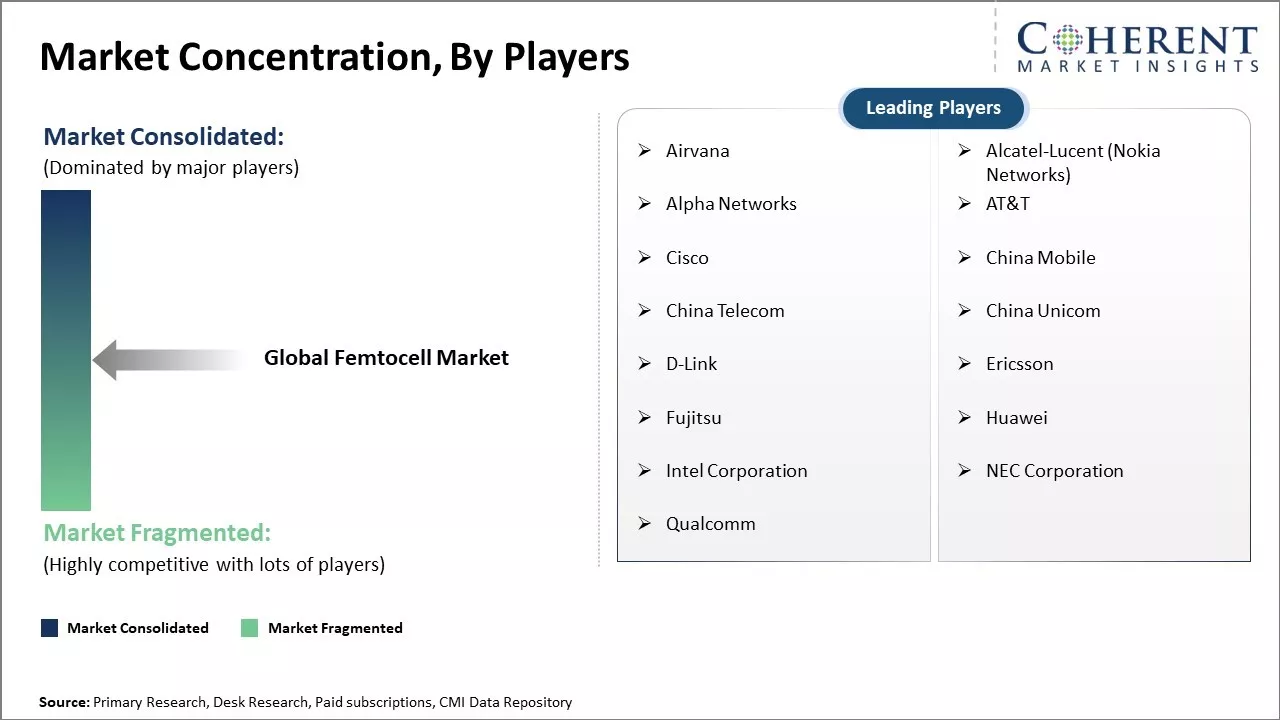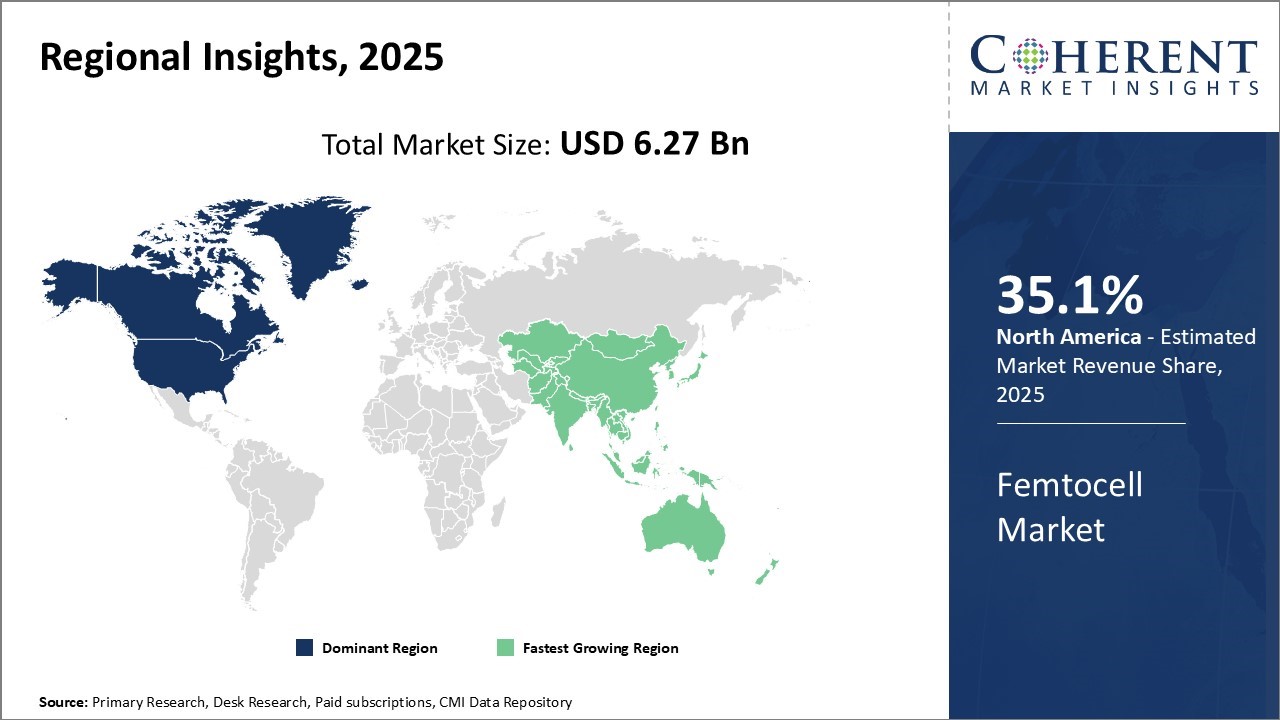The Global Femtocell Market is estimated to be valued at USD 6.27 Bn in 2025 and is expected to reach USD 21.45 Bn by 2032, exhibiting a compound annual growth rate (CAGR) of 19.2% from 2025 to 2032.

To learn more about this report, Download Free Sample
The global Femtocell Market is experiencing steady expansion, driven by increasing mobile data traffic, growing demand for enhanced indoor network coverage, and rising 5G deployment worldwide. 5G femtocells are gaining popularity due to their ability to deliver high-speed, low-latency connectivity in dense urban and residential environments. IU-H technology remains dominant, offering reliable integration with existing network infrastructure.
|
Current Event |
Description and its impact |
|
Technology Commercialization and Product Launches |
|
|
Strategic Investments and Collaborations |
|
|
Technology Commercialization and Product Launches |
|
Uncover macros and micros vetted on 75+ parameters: Get instant access to report
The pricing structure of femtocells in 2025 varies significantly based on technology type (3G, 4G, 5G), user capacity, and end-user application (residential, enterprise, or public). Entry-level residential femtocells typically range from USD 100 to USD 250, while enterprise-grade and 5G-compatible units can cost between USD 500 to USD 1,200 due to their advanced capabilities such as higher bandwidth support, improved latency, and broader coverage. Costs are further influenced by integration features, security protocols, and network interoperability.
Vendors are adopting flexible pricing strategies including subscription models and bundled service plans in collaboration with telecom operators to reduce upfront costs for end-users. Additionally, economies of scale, ongoing technological advancements, and chipset standardization are gradually lowering production costs, especially for IU-H and 5G models. However, in regions with limited spectrum availability or regulatory restrictions, deployment costs remain higher, affecting overall pricing dynamics across different markets.
The femtocell market is experiencing rapid technological advancements aimed at enhancing signal quality, minimizing latency, and ensuring smooth integration with next-generation network infrastructure. A significant development is the introduction of 5G-enabled femtocells, which offer ultra-low latency and high-speed connectivity for demanding applications such as augmented reality (AR), virtual reality (VR), and 4K video streaming.
These advanced femtocells also feature network slicing and edge computing capabilities, ensuring efficient and tailored service delivery for both residential and enterprise users. Moreover, femtocell technology is playing a crucial role in expanding broadband access in rural areas, bridging the digital divide by providing reliable, high-quality connectivity in underserved regions.
This growing focus on Broadband in rural areas Femtocell Market highlights the potential of femtocells to transform connectivity across diverse geographic and socioeconomic landscapes.
Another breakthrough is the integration of AI and self-organizing network (SON) features that enable femtocells to automatically optimize coverage and handovers based on user traffic patterns and environmental factors. Furthermore, cloud-based management systems are being adopted to facilitate remote diagnostics, provisioning, and updates. These technological enhancements are not only increasing the reliability and scalability of femtocell deployments but also aligning them with evolving demands in smart homes, IoT ecosystems, and future-ready telecom networks.

To learn more about this report, Download Free Sample
With the explosive growth of mobile data usage driven by video streaming, social media, and cloud computing, the demand for high-quality mobile networks continues to increase exponentially. Traditional microcell networks alone are finding it difficult to cope up with this surge as their coverage and capacity are limited.
On the other hand, mobile operators need to improve network performance and customer experience to retain existing subscribers and attract new ones. This is where femtocells are playing a vital role by enhancing network coverage and boosting data capacity.
Femtocells offer independent and dedicated connectivity for users in confined areas like homes and offices. Their short range allows operators to add many low-power nodes in places where coverage was poor earlier. This has helped operators tremendously in plugging network gaps and black spots that previously existed indoors.
By offloading mobile data traffic onto the femtocell network from the macros, operators are also able to reduce network congestion and free up bandwidth. As a result, users enjoy stronger indoor reception, faster data speeds, and a consistent mobile broadband experience.
For operators, femtocells translate to improved customer satisfaction, lower churn rates, and reduced infrastructure spending compared to deploying additional macros. It is therefore not surprising that major carriers globally have been aggressively deploying femtocells to meet the insatiable demand for high-speed data connectivity.
In June 2024, RCR Wireless News highlighted that Vodafone Spain and the University Polytechnic of Valencia (UPV) partnered to deploy a 5G stand-alone Open RAN femtocell network in Valencia. This academic-industry collaboration aims to support advanced 5G research and validation in compact urban environments.
Another key driver for the femtocell industry growth is the ongoing migration towards newer wireless technologies that require sophisticated indoor solutions. While 4G LTE took networks to the next level, it also posed new indoor coverage challenges due to its higher penetration losses through walls and other barriers.
At the same time, users have higher expectations of superfast data speeds everywhere on their 4G devices. To address this, operators are widely adopting LTE femtocells that provide robust in-building 4G reception similar to macros. As 5G networks commence commercial rollouts over the next few years, indoor 5G small cells will become indispensable for seamless coverage indoors. 5G promises ultra-low latency along with multi-Gbps peak speeds to support mission-critical services, and indoor networks will play a key supporting role.
Consequently, all major mobile standards evolutions will continue fuelling femtocell adoption amongst network operators keen on superior indoor user experience. Vendors are also innovating new form factors, multi-technology capabilities and ease of management to help operators.
In October 2024, Telecom Ramblings reported on Axyom.Core launching the industry’s first 4G/5G dual-mode enterprise femtocell. Designed for small offices, hospitals, and retail environments, this compact device offers seamless indoor cellular coverage with both NSA and SA architectures—catering to growing demand from service providers and enterprise clients.
One of the major challenges restricting the expansion of the global femtocell market is interference issues with existing macro mobile networks. Femtocells operate within the same spectrum as traditional cellular networks, which means they can cause interference to macrocells and vice versa. Since femtocells have a very small coverage range of just 10 meters typically, even minor interference can disrupt voice and data services for users.
Coordination between femtocells and nearby macrocells is critical so that they do not transmit on the same channel and cause disruptions. However, achieving perfect coordination at a mass scale is still a technical challenge. This is a significant problem especially in densely populated areas where frequencies get crowded. Without proper interference management, the user experience on femtocells would be severely compromised which discourages operators and customers from adopting this technology.
Additionally, the proliferation of unmanaged or rogue femtocells poses new interference risks. Rogue devices are not connected to the operator’s network and their location and activities cannot be monitored. They threaten to interfere with authorized transmissions if not configured and installed correctly.
The changing work dynamics have opened new opportunities for the femtocell market globally. This has pushed the need for reliable and affordable connectivity even in remote locations. Femtocells cater precisely to this rising need.
Femtocells offer cost-effective indoor cellular coverage for homes and small businesses by connecting to the internet via broadband and acting as miniature base stations. When employees work remotely, femtocells ensure seamless connectivity and call/data coverage within offices set up at home. They are proving helpful for families as well where multiple devices are used for work, online classes and entertainment simultaneously.
The IU-H segment is projected to dominate the global femtocell market with a substantial 61.9% share in 2025. Its widespread compatibility with existing 3G and 4G infrastructure allows for smooth integration and seamless handovers between macro and micro networks.
IU-H technology offers strong voice call quality, secure handoffs, and reliable data connectivity, making it the go-to solution for telecom operators aiming to improve indoor mobile performance.
Its high scalability and ease of deployment have led to large-scale adoption in enterprise and residential environments. As demand for enhanced indoor coverage in urban buildings, offices, and homes continues to grow, IU-H remains the preferred choice for femtocell technology, ensuring sustained dominance through 2025.
5G femtocells are expected to account for 48.6% of the femtocell market in 2025. This growth is driven by skyrocketing data consumption for high-speed applications such as UHD video streaming, online gaming, and immersive technologies like AR/VR. 5G femtocells are specifically designed to support low latency and high-capacity connections within compact areas.
With their ability to address coverage challenges in high-rise buildings, stadiums, and crowded urban locales, 5G femtocells are rapidly being deployed by operators to complement macro networks. Their role is especially critical in delivering consistent indoor 5G experiences where large towers fail to penetrate, making them an essential tool in the next-gen network ecosystem.
The residential segment is anticipated to lead the femtocell market with a 53.2% share in 2025, propelled by rising demand for uninterrupted mobile coverage at home. As remote work, e-learning, and IoT-connected smart homes become more common, households are seeking affordable and effective indoor connectivity solutions.
Femtocells offer users the ability to boost mobile signal strength in apartments, suburban houses, and rural areas where traditional network coverage may be weak or inconsistent. With simple plug-and-play setups and operator support, residential femtocells are becoming a preferred solution for home users demanding strong and reliable broadband and voice services.

To learn more about this report, Download Free Sample
North America is projected to retain its leadership in the global femtocell market, accounting for an estimated 35.1% share in 2025. This dominance is underpinned by the region’s advanced telecom infrastructure, high smartphone penetration, and early adoption of 5G technologies across both urban and rural landscapes.
The U.S. and Canada host several key network operators and infrastructure providers that are actively deploying femtocell solutions to address indoor connectivity gaps and enhance service quality in underserved areas.
The rise in remote work, smart home usage, and IoT integration is fuelling the demand for seamless indoor coverage, particularly in residential and small office environments. Moreover, favourable regulatory frameworks, increased spectrum availability, and public-private partnerships aimed at closing the digital divide are accelerating the rollout of femtocell networks. As telecom providers continue to invest in small cell infrastructure and next-gen connectivity, North America remains a strategic hub for femtocell innovation and commercial adoption.
The United States is a frontrunner in the global femtocell market, driven by its robust telecom infrastructure, early adoption of 5G networks, and rising demand for uninterrupted indoor connectivity. U.S. telecom giants such as Verizon, AT&T, and T-Mobile are actively investing in femtocell deployments to enhance network performance in residential, enterprise, and rural environments.
The nation's emphasis on smart home integration, remote work, and IoT connectivity has further accelerated the adoption of femtocells. Additionally, favourable FCC spectrum policies, government initiatives to bridge digital gaps, and a tech-savvy consumer base ensure that the U.S. maintains its leadership in next-gen small cell technologies.
Canada complements this growth with strategic investments in broadband infrastructure and an increasing focus on enhancing rural connectivity. Canadian telecom providers like Rogers and Bell are leveraging femtocell solutions to address indoor signal challenges and improve coverage in less densely populated areas.
Government-supported programs aimed at expanding 5G networks and fostering digital inclusivity have made Canada a critical contributor to North America’s strength in the femtocell ecosystem. Combined, both nations form a powerhouse driving technological innovation, network densification, and commercial-scale adoption of femtocell solutions across the region.
| Report Coverage | Details | ||
|---|---|---|---|
| Base Year: | 2024 | Market Size in 2025: | USD 6.27 Bn |
| Historical Data for: | 2020 To 2024 | Forecast Period: | 2025 To 2032 |
| Forecast Period 2025 to 2032 CAGR: | 19.2% | 2032 Value Projection: | USD 21.45 Bn |
| Geographies covered: |
|
||
| Segments covered: |
|
||
| Companies covered: |
Airvana, Alcatel-Lucent (Nokia Networks), Alpha Networks, AT&T, Cisco, China Mobile, China Telecom, China Unicom, D-Link, Ericsson, Fujitsu, Huawei, Intel Corporation, NEC Corporation, and Qualcomm |
||
| Growth Drivers: |
|
||
| Restraints & Challenges: |
|
||
Uncover macros and micros vetted on 75+ parameters: Get instant access to report
Share
Share
About Author
Suraj Bhanudas Jagtap is a seasoned Senior Management Consultant with over 7 years of experience. He has served Fortune 500 companies and startups, helping clients with cross broader expansion and market entry access strategies. He has played significant role in offering strategic viewpoints and actionable insights for various client’s projects including demand analysis, and competitive analysis, identifying right channel partner among others.
Missing comfort of reading report in your local language? Find your preferred language :
Transform your Strategy with Exclusive Trending Reports :
Frequently Asked Questions
Joining thousands of companies around the world committed to making the Excellent Business Solutions.
View All Our Clients